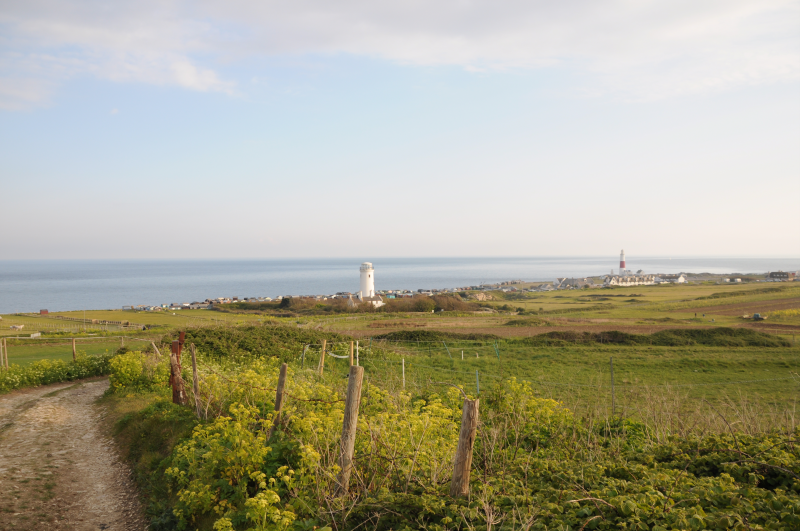Average Birding

Portland, Spring 2021, Part #3
To the island of Portland we have gone. In this post we recount the events of days five and six of the trip, which were at the time known as the 29th and 30th April, 2021.
A fly in the ointment
Plans for a day off the island do not start well when we discover a note on our car informing us that a local bus has scraped the front right wing. The damage looks superficial, but our previous experience with damaging hire cars tells us we'd best get it assessed and fixed before we do anything else. That takes us 'til lunchtime.
Arne - a reserve of two halves
This apparently is not pronounce like "Arnie" (as in Schwarzenegger) to AB1's significant distress.
The first half is great for views, but, for us at least, not too great for birds.
Despite the close attention of the bus to our car, we still have plenty of time to head to our original planned destination of RSPB Arne. We get there around half past one, park up, then head out onto the nearest available trail in search of the first appropriate place to lunch. It doesn't take long - we choose the Shipstal trail and maybe 200m in there's a couple of plank style benches with a nice view over some gorse towards the harbour. Sandwiches are eaten. Stonechats are seen. A distant Cuckoo calls.
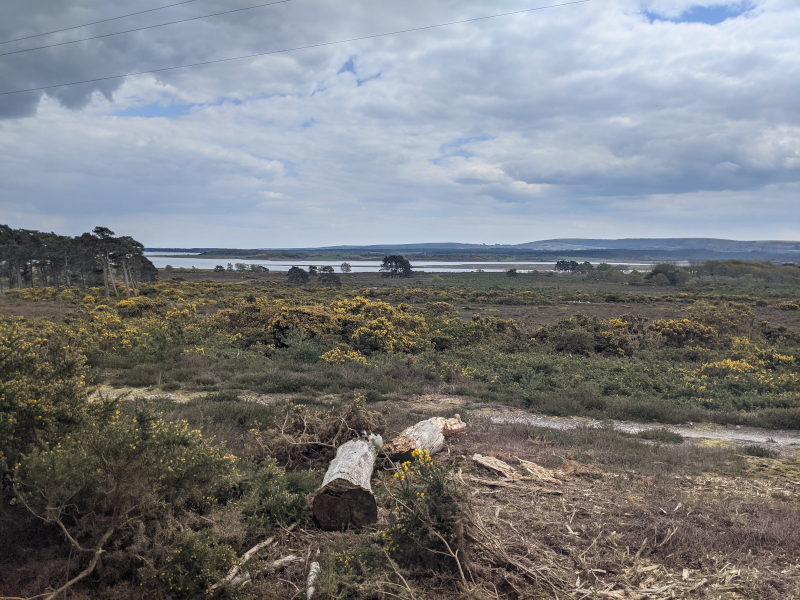
The remainder of the trail is great for views but a bit quiet for birds. We find plenty of Mistle Thrush in the fieldy bits, and there's a Green Woodpecker yaffling somewhere, but otherwise, all is quiet.
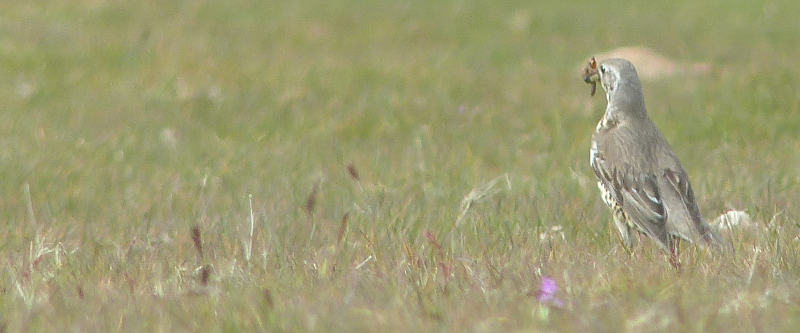
Perhaps our timing is awry. The lack of birds is more surprising when we get to the parts of the trail that border the harbour.

Here the gorse just inland is thick, there are good trees nearby - this ought to be full of birds. But it is not - where we would expect clouds of Stonechat we find not even a single Linnet. All we find is a frightened looking deer or two. Curious!

We trundle back to the car to stash the superfluous scope before heading out to have a look at the Coombe Heath trail.
The Coombe Heath trail is sunny but also lacking in life - we find three Stonechat rather than one, though, and a potential Tree Pipit was spotted.
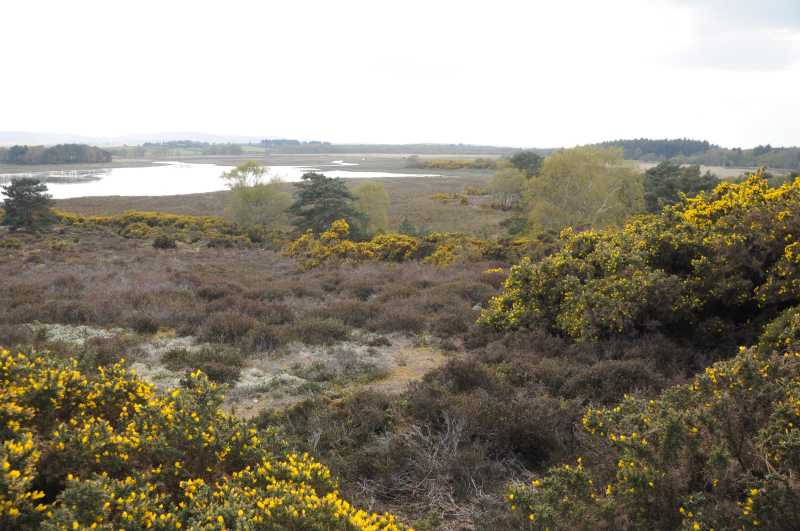
As we exit the circuit, a pair of folk quiz us on where they're most likely to see the Ospreys. Ospreys? Apparently there's a nest on a stick somewhere in the harbour that you can see from this trail. This is the first we've heard of it, but we do know, at least, that this trail is circular, and the watery bits are half way around, so whichever way they go they'll get there. Later on I remember the existence of The Poole Harbour Osprey Project and feel a bit silly for being so uninformed. Oh well.
The second half
Finally, we try the Hyde Heath trail. And this bit delivers. The vegetation feels a bit more like heathland than where we've been so far - stands of conifers, mixed gorse and short trees, but not too much of either. We're reminded of our trip to Thursley Common.
There's plenty of activity too - admittedly too distant to identify, but stuff is at least about. We once again choose the positive (anti-clockwise) direction, and we're soon following a pair of Stonechat up the hill. Will this find us a Dartford? Not immediately - we scan underneath wherever the Stonechats sit for signs of activity but find nothing.
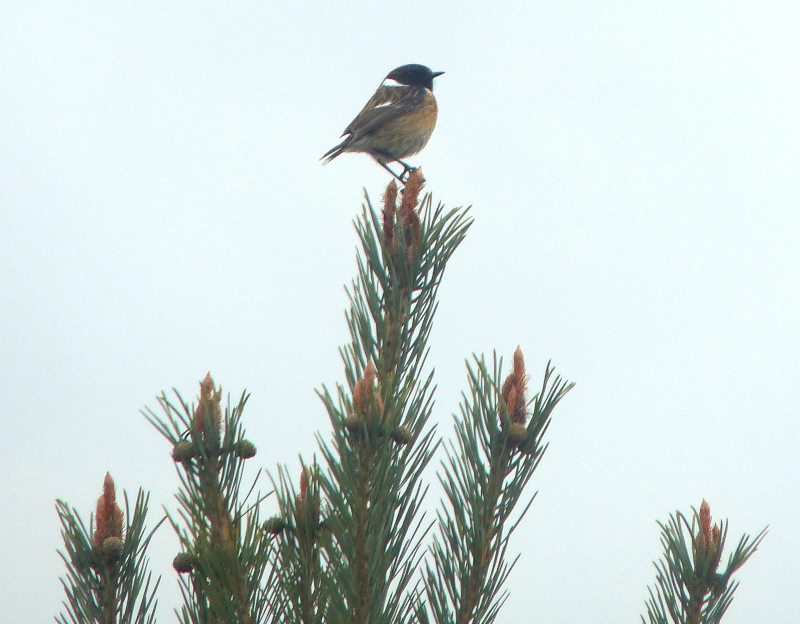
When we reach the top corner of the trail though, an odd scratchy song kicks off. That is not Stonechat. What is it, though? AB2 points out some bird sitting on a tiny shrub, and we stare at it. Female stonechat? No, no, that's Dartford, look at that tail. And that's the thing singing! It stays still long enough that we dare to dream of photographing it, but inevitably this turns out to be completely impossible. Worse than Whinchat for shyness.
We interrogate every further Stonechat for Dartford friends, but find none. We do encounter a Siskin a bit further around though, which is a nice surprise. It's "see you" call reminds us of our trip to Scotland, where it went from "what the hell is that" to "aaaah, Siskin again" over the course of a week or so. An unbidden memory of what turns out to be something Russ Abbott related appends "Jimmy" to the "see you" call in a terrible Scottish accent.

The vegetation at the sides of the path starts to change from gorse and sticky bushes to short trees only, and the birds change with it. Four or five Tree Pipits are making song flights between these treelets, and they are photogenic enough for us to manage a capture or two.

Even better, there's a sharp winged bird of prey carving into a collection of conifers at the bottom of the hill, and we're onto it quickly enough to spot the hint of red trousers that means it can only have been a Hobby (a bird of that shape heading into conifers from a heathland to do some perching could be very little else).
We try to pick out the Hobby in the trees when we get a little closer, but it is completely hopeless - we're too far away, and there are too many possible perching branches for us to check. We'll have to make do with the now constant plea for attention from nearby Tree Pipits, which are just desperate to display for us in the evening sunshine. Barring a brief break where we briefly fail to work out that the cause of a weird noise is squirrels, there ended the birding of note at Arne, and it was time for us to head home.
The 6th Day
We should never have mentioned Arnold. We haven't even seen that one.
For once, we haven't got much of a plan for the start of the day. We consult twitter, and find some advice that Portland Castle might be a place to start our day.
Portland Castle Pied Flycatcher, Spotted Flycatcher, Lesser Whitethroat, Blackcap and 3 Willow Warblers
— Debby Saunders (@debbyseamist) April 30, 2021
We'll start out there then and see what happens.
Portland Castle
What happens is immediately pretty good - it feels like the hordes of Willow Warbler from Wednesday are now congregating here, in the last tiny green space before they have to take on the terrifying bulk of the rest of the UK. I find myself in a strange state of sympathy with them, now we're reaching the tail end of our time here. Do we have to go back? Can't we stay here, where it's green, and things seem so friendly?
We took only a brief look at the castle on our orientation walk and were put off by the English Heritage hut, which we assumed would lead to eye watering entrance charges. Today we are more curious, the hut is empty and the path into the gardens attached to the castle appear to be open and unguarded. We sidle in and park ourselves next to a giant gate, so the sun's right behind us.
Things start to happen very quickly. A Lesser Whitethroat is fussing in the hedge to the right of where we came in. Another bird is sitting on a smaller gate opposite us; it hops into the air, does a little mid-air dance, and then lands on the lawn with its back to us with an unmissable flash of red. Female Common Redstart.

In the trees above the wall, another bird hops out from a perch, cavorts midair to catch a fly, and then returns to the same perch. That'd be...Spotted Flycatcher then. Further to the right in some less grandiose trees, a further spotty is doing the same thing. A supporting cast of Willow Warblers provides activity towards the edges of the stage.
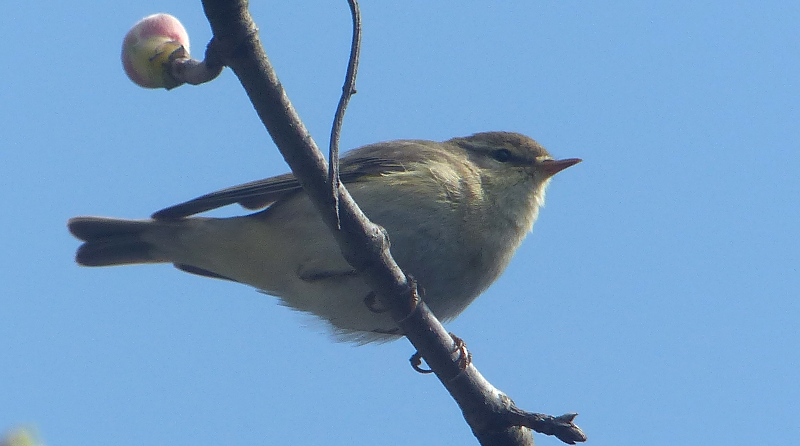
This is great. There's always something a bit special about finding flycatchers at any time, and in this perfect little secluded space at the Northern tip of Portland that feeling is amplified. Wonderful.
Word is evidently out that this is the place to be - a pair of well-equipped folks turn up and make a beeline for us. What have we seen? We give a report of what we've found so far. "No Pied Flycatcher?" "We haven't found one yet. Are you reading Debby's tweets as well then?" "Yes". How brilliant is it that twitter turns out to be good for bird news?
Having shared all our sightings, we feel compelled to try to find all of them again for our new acquaintances, and we just about manage it, even if our somewhat flowery descriptions of copper leaved trees as "autumnal" isn't perhaps the most helpful. In return, we get some excellent intel - there are apparently a pair of Black-winged Stilts at Lodmoor! Well, we'll have to go there next then.
These folks have driven across from Wareham, but they haven't been to Arne yet. They admit that this is what usually happens - they stay near Wareham but end up on Portland every day. I can see why! We tell them of our Arne experience; they tell us that they've long ago stopped bothering with the Shipstal trail because they never see anything there either. Well this is all very useful.
We eventually reach a point where we really ought to head out to find the Black-winged Stilts, but before we do we want to have a quick look at the parts of the garden that are hidden from us by the wall to our East. We make our way through the Redstart gate and turn left, and through a stone portal there's a small circular lawn which...is...covered in Willow Warblers; there must be ten or fifteen of them poking at it in hope of insects. Mad. What a place.
We head back out, say a quick goodbye to our new friends ("you managed to send the Redstart right out to us, thanks") and hop back in the car. To Lodmoor!

Lodmoor
We park up on the residential road (not just motivated by cheapness this time; our castle informants told us this is where to go). Before we've even got any kit out of the car, three separate groups of people (one of whom stops her car in the middle of the road) ask us what's got everyone so excited. Are we just more approachable than the twenty odd bescoped folks down the road in some? We happily explain, and offer a scoped view once we're set up if they're interested.
Once we're free of questioners, I make a beeline towards where everyone else is standing and...oh my goodness the birds are basically 10m from the hedge. That's an unbelievable view. I hurriedly get the scope set up, but in the time between taking my eye off the birds and on to the scope, they disappear. Did I imagine the whole thing? No - they've just retreated to a more standard 50m or so, towards the back of the area of water we can see from here. Humph.
A less bothered AB2 catches up from a brief messing about in the car and is unimpressed. "Was that your fault?". I do my best innocent face, and offer up a newly reconfigured scope pointing at where the Stilts now are.
We hold our horses on that while a few interested locals take a look through the scope and make appropriate ooooh noises. The scene's helped by a crowd of hirundines swooping around the same bit of water. Perhaps they're also excited to see BWS up here. What a sight.
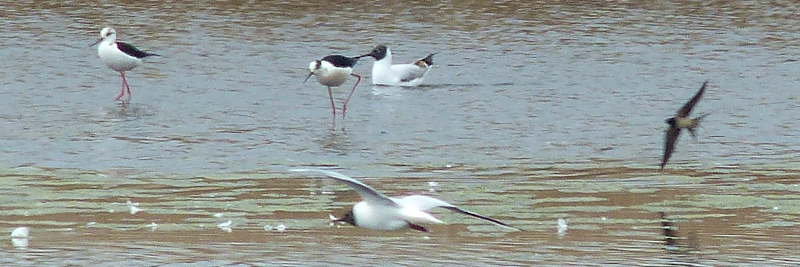
Our next stop is most definitely lunch, for which we'll briefly head back to base.
Bill walk
The afternoon rolls around, and it's time for another walk around the bill. We park up in Southwell just as school is out, dodge the hordes of children and parents on a quick tour of the estate, park, and the quickly detour the path we'd planned to get out on to the cliff path, away from the disturbance of everyone heading for home.
This turns out to be a good plan - we pick up a nice Stonechat on the Northern edge of the business park, and a Kestrel heading along the cliff edge (same bird as Tuesday maybe?). We consider heading down Reap Lane on the advice of other recent tweets, but we decide we prefer the look of Barleycrates instead.
This again turns out to be a good choice, because at the quarry towards the end of that path, we come across a pair of Whinchat, and after an extended period of trying really hard, manage some passable photos of. We also introduce a pair of passing folk to them; they're locals, and apparently this is the first time they've seen one. Always a delight to hand out a life-tick!

At the end of Barleycrates we do a bit of staring at the sky. Are we about to get very wet? We decide that the weather gods are going to be on our side, and leave Portland dry, despite the evidence of the occasional spot of rain on AB1's glasses. We decide to have a trundle around the hump and the surrounding quarry. Mostly we find more Willow Warbler and Linnet.
At a point where our path splits into three though, we go for a bit of an explore and find some things of more interest; a Kestrel preening on the quarry's edge. A Buzzard, squeaking angrily at...itself? It seems keen to demonstrate that it is the Buzzard of the quarry, but looking up we find no other Buzzards it could be trying to convince. Good to know Buzzards suffer from egotism too.
Now and again there's a hint of a much more interesting sound - the insectile reeling of a Grasshopper Warbler. It's impossible to place it anywhere other than "distant" though. We try moving ourselves to see if we can triangulate it, but the bird doesn't keep singing consistently enough for us to get anywhere. That'll have to do.
We head back towards Avalanche Road to explore if the pub is open yet. If it is, it doesn't appear interested in showing it. Humph. A bit more walking then - we turn and head up Sweet Hill, to revisit Sunday evening's Wheatear field. No Wheatears this time. More Linnet though. Not a lot else. A quick pass by the bird obs; more Willow Warbler.
Our real target has always been the Pulpit Inn though. We stop for a pint and a relax with the last of the light, then head back to base via a curry from Easton.
